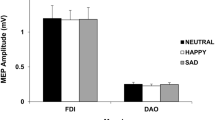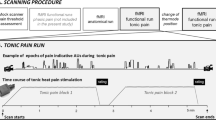Conclusions
-
1.
The process of recognition of mimicked signs of an emotional state depicted on a photograph of a person involves two stages: 1) A preliminary recognition of emotion, accompanied by an involuntary cutaneous-galvanic reaction; 2) a definitive decision that the subject communicates by a voluntary motor reaction.
-
2.
The first (involuntary) stage of recognition may involve components of an orientational reflex, which is indicated by the high percentage of “incorrect” cutaneous-galvanic reactions.
-
3.
The ratio of correct and incorrect cutaneous-galvanic reactions during the recognition of emotions is largely independent of the localization of the cortical injury. At the same time, the localization of the injury significantly affects the ratio of correct and incorrect voluntary motor reactions.
-
4.
Injury of the investigated segments of the right hemisphere disrupts the process of recognition as a whole, while pathology of the left preferentially affects the stage of definitive decision making, which the subject communicates by a voluntary motor reaction.
Similar content being viewed by others
Literature cited
N. N. Bragina and T. A. Dobrokhotova, Functional Asymmetries in Man [in Russian], Meditsina, Moscow (1981).
T. I. Grekova, “Cutaneous-galvanic reflex as an indicator of changes in psychological state,” Fiziol. Cheloveka,1, No. 6, 993 (1975).
V. A. Deglin and N. N. Nikolaenko, “Role of dominant hemisphere in regulating emotional states,” Fiziol. Cheloveka,1, No. 3, 418 (1975).
É. A. Kostandov, Perception and Emotion [in Russian], Meditsina, Moscow (1977).
É. A. Kostandov, Functional Asymmetry of the Cerebral Hemispheres and Unconscious Perception [in Russian], Nauka, Moscow (1983).
M. A. Kulikov and O. A. Sidorova, “Recognition of intonational and mimic signs of emotions by patients with organic injuries of left and right cerebral hemisphere,” Zh. Vyssh. Nervn. Deyat.,33, No. 3, 456 (1983).
O. A. Sidorova, P. V. Simonov, and L. S. Tsvetkova, “Method for study of perception of signs of emotional state in man,” Zh. Vyssh. Nervn. Deyat.,28, No. 2, 415 (1978).
P. V. Simonov, Higher Nervous Activity of Man, Motivational-Emotional Aspects [in Russian], Nauka, Moscow (1975).
S. Springer and G. Deutsch, Left Brain, Right Brain [Russian translation], Mir, Moscow (1983), p. 252.
L. S. Tsvetkova, O. A. Sidorova, and M. A. Kulikov, “Localization of human cerebral injuries and characteristics of recognition of emotional expression,” Zh. Vyssh. Nervn. Deyat.,34, No. 3, 421 (1984).
R. Bruyer, “Implication differentielle des hemispheres cérébraux dans les conductes émotionneles,” Acta Psychiat. Belg.,80, No. 3, 266 (1980).
L. I. Benowitz, D. M. Bear, R. Rosenthal, M. M. Mesulam, E. Zaidel, and R. Sperry, “Hemispheric specialization in nonverbal communication,” Cortex,19, No. 1, 5 (1983).
P. De Bastiani, G. Di Palma, V. C. Monetti, and M. G. Palmonari, “Perceiving emotional conditions in brain-damaged and normal people,” Behav. Brain Res.,8, No. 2, 236 (1983).
J. Espinas, “Aspect neurophysiologiques de la lateralite,” Rev. Neuropsychiat. Infant. Hyg. Ment. Entance,23, No. 1, 5 (1975).
P. M. Forster and E. Govier, “Discrimination without awareness?” Q. J. Exp. Psychol.,30, No. 2, 289 (1978).
N. Geschwind, “Specializations of the human brain,” Sci. Am.,241, No. 3, 158, 168 (1979).
I. Malman, D. G. Rogkin, and C. Wolff, “Latent inhibition of the GSR conditioned to words,” Physiol. Psychol.,7, No. 2, 193 (1979).
J. F. O'Gorman, “The orienting reflex: novelty of significance detector?” Psychophysiology,16, No. 3, 253 (1979).
D. S. J. Shackel, “Effects of stimulus incongruity, task demand, and induced involvement on amplitude of GSR,” Percep. Motor Skills,43, No. 3, Part 2, 111 (1976).
Author information
Authors and Affiliations
Additional information
Clinical portion of work performed under supervision of L. S. Tsvetka at the Nervous Diseases Clinic, First Medical Institute, Moscow.
Translated from Zhurnal Vysshei Nervnoi Deyatel'nosti imeni I. P. Pavlova, Vol. 36, No. 2, pp. 309–318, March–April, 1986.
Rights and permissions
About this article
Cite this article
Sidorova, O.A., Kulikov, M.A. Comparison of cutaneous-galvanic and voluntary reactions during recognition of emotional mimicry. Neurosci Behav Physiol 17, 236–244 (1987). https://doi.org/10.1007/BF01191257
Received:
Issue Date:
DOI: https://doi.org/10.1007/BF01191257




